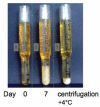Mixed cryoglobulinemia
- PMID: 18796155
- PMCID: PMC2569912
- DOI: 10.1186/1750-1172-3-25
Mixed cryoglobulinemia
Abstract
Mixed cryoglobulinemia (MC), type II and type III, refers to the presence of circulating cryoprecipitable immune complexes in the serum and manifests clinically by a classical triad of purpura, weakness and arthralgias. It is considered to be a rare disorder, but its true prevalence remains unknown. The disease is more common in Southern Europe than in Northern Europe or Northern America. The prevalence of 'essential' MC is reported as approximately 1:100,000 (with a female-to-male ratio 3:1), but this term is now used to refer to a minority of MC patients only. MC is characterized by variable organ involvement including skin lesions (orthostatic purpura, ulcers), chronic hepatitis, membranoproliferative glomerulonephritis, peripheral neuropathy, diffuse vasculitis, and, less frequently, interstitial lung involvement and endocrine disorders. Some patients may develop lymphatic and hepatic malignancies, usually as a late complication. MC may be associated with numerous infectious or immunological diseases. When isolated, MC may represent a distinct disease, the so-called 'essential' MC. The etiopathogenesis of MC is not completely understood. Hepatitis C virus (HCV) infection is suggested to play a causative role, with the contribution of genetic and/or environmental factors. Moreover, MC may be associated with other infectious agents or immunological disorders, such as human immunodeficiency virus (HIV) infection or primary Sjögren's syndrome. Diagnosis is based on clinical and laboratory findings. Circulating mixed cryoglobulins, low C4 levels and orthostatic skin purpura are the hallmarks of the disease. Leukocytoclastic vasculitis involving medium- and, more often, small-sized blood vessels is the typical pathological finding, easily detectable by means of skin biopsy of recent vasculitic lesions. Differential diagnoses include a wide range of systemic, infectious and neoplastic disorders, mainly autoimmune hepatitis, Sjögren's syndrome, polyarthritis, and B-cell lymphomas. The first-line treatment of MC should focus on eradication of HCV by combined interferon-ribavirin treatment. Pathogenetic treatments (immunosuppressors, corticosteroids, and/or plasmapheresis) should be tailored to each patient according to the progression and severity of the clinical manifestations. Long-term monitoring is recommended in all MC patients to assure timely diagnosis and treatment of the life-threatening complications. The overall prognosis is poorer in patients with renal disease, liver failure, lymphoproliferative disease and malignancies.
Figures










References
-
- Wintrobe M, Buell M. Hyperproteinemia associated with multiple myeloma. With report of a case in which an extraordinary hyperproteinemia was associated with trombosis of the retinal veins and symptoms suggesting Raynaud's disease. Bull Johns Hopkins Hosp. 1933;52:156–65.
Publication types
MeSH terms
Substances
LinkOut - more resources
Full Text Sources
Miscellaneous

